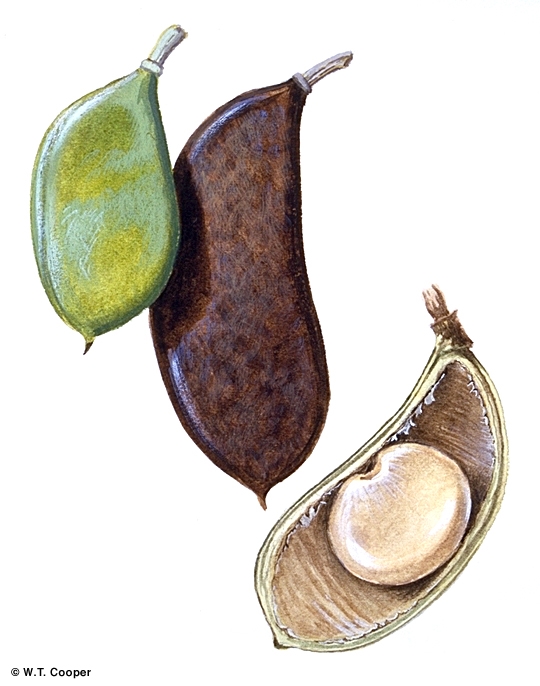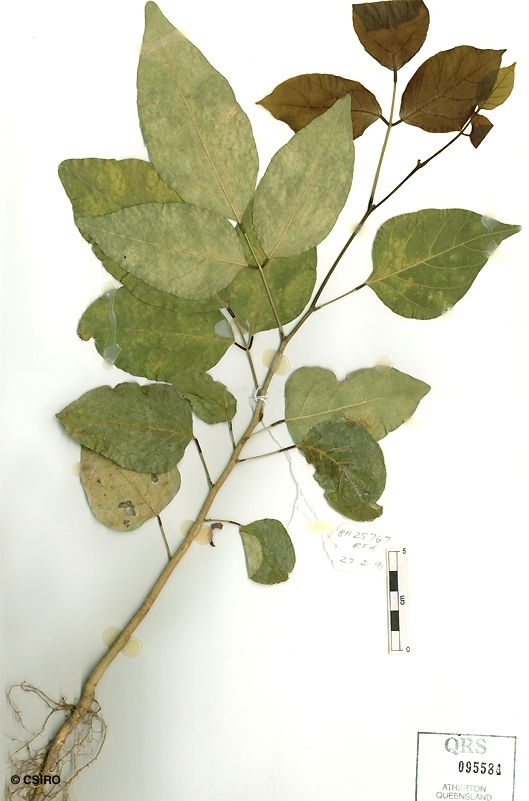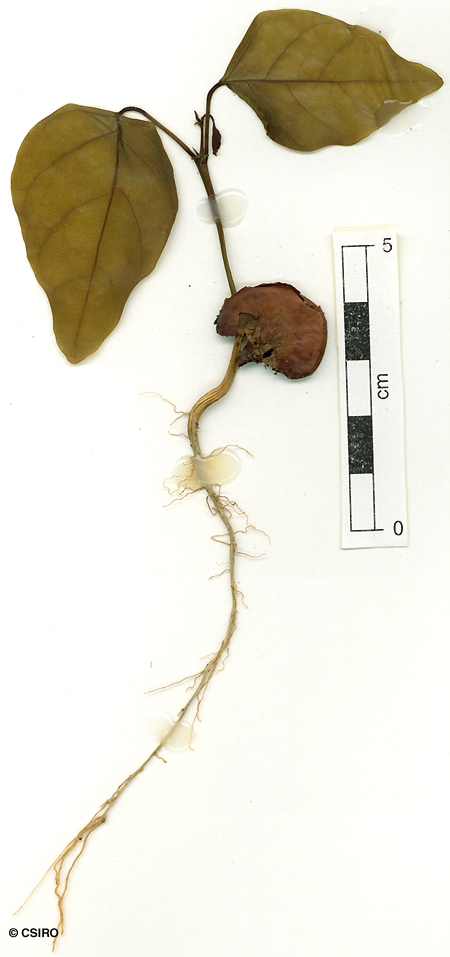Australian Tropical Rainforest Plants - Online edition
Pongamia pinnata (L.) Pierre var. pinnata






Panigrahi, S.G., (1989) Flora Bilaspur District 1: 210 (1989).
Pongam; Pongamia Tree; Indian Pongamia; Indian Beech; Pongamia
Tree up to 15 m, sporadically deciduous, diameter at breast height at least up to 80 cm; branches often horizontal or pendulous. Indumentum on new growth consists of black or pale hairs, sometimes both colours are intermingled, denser at nodes and on new leaflets and stipules, the black hairs shedding first. Stipules oblong or oblong-elliptic, spathulate, ovate, obliquely ovate, flat, 3-8 mm long, 1.5-3 mm wide, apex obtuse or acute. Bean-like (Phaseolus vulgaris) odour often detectable in the blaze.
Leaf rachis + petiole 70-220 mm long; petiolules 6-16 mm long; leaflets 3–5 (rarely 7); lateral leaflets 33-200 mm long, 25-120 mm wide; terminal leaflets 45-280 mm long, 38-170 mm wide; new growth bright green, occasionally reddish or brownish-green becoming bright green well before full expansion; secondary veins on basal leaflets 3-6 pairs, secondary veins on terminal leaflets 5-7 pairs, angle of divergence 35-50 degrees, flush on upper side and raised on underside.
Inflorescences 5- to ca. 100-flowered, a raceme or rarely a 2-branched panicle 20-300 mm long; rachis pubescent with blackish or fawn appressed hairs; bracts broadly ovate, 1-2.5 mm long, 1-1.8 mm wide, cupped vertically around buds at dehiscence; pedicels 8-12 mm long; bracteole diameter 0.25-0.5 mm, pubescent with coppery-black hairs. Flowers: calyx 4-5 mm long, diameter 5.5-6 mm, abaxially clothed in appressed blackish hairs (or fawn in Northern Territory); standard suborbicular, apex emarginate, 11-13.5 mm long (including claw 2-2.5 mm long) and 12-13 mm wide, blackish hairs on abaxial surface; wings narrowly oblong, 12-13 mm long (including claw ca. 3 mm long) and ca. 2.5 mm wide at base, pink, purplish-pink or whitish, black appressed hairs towards apex and on centre of both surfaces; lower margin at base cuneate; keel obovate, 11-12 mm long (including claw ca. 2.5 mm long) and ca. 4mm wide, white, blackish appressed hairs on abaxial surface; anthers 10, ovate, ca. 1mm long and 0.5 mm wide; disc upper surface lobed, 0.5-1 mm high; ovary 7.5-9 mm long including stipe 1-2 mm long, clothed in black hairs.
Fruit pedicel 2.5-12 mm long; pod 39-62 x 15-26 x 7-10 mm, brown or blackish, glabrescent with sparse minute hairs near base, base attenuate, apex beaked, inner mesocarp wall papery, exocarp 1.5-2.5 mm thick; seeds reniform, rounded-reniform, laterally compressed, 11.5-16 x 10-18 x 3.5-12 mm, testa cream, pinkish-brown to brown, hilum diameter 1.5-3 mm
Occurs in NT, CYP, NEQ and CEQ. Mostly mostly occurs in littoral rainforest along the seaward margin, or occasionally in adjoining dune swales; also in riparian forest, monsoon forest, vine thickets and behind mangroves (see Cooper et al 2019 for more detailed information). Also occurs in the Asia, Malesia, New Caledonia and other Pacific islands.
This species may have medicinal properties, and has been used as a fish poison.
In Australia the tree's main use has been as an Aboriginal fish poison, but it has been useful medicinally elsewhere, especially in India. Juice from the fresh leaves is regarded as having medicinal value. The roots are regarded as a contraceptive. Cribb (1981).
Pongamia pinnata (L.) Pierre, Flora Forestiere de la Cochinchinensis : Pl. 3 (1899). Pongamia pinnata var. typica Domin, Bibliotheca Botanica 89(3): 787(1926). Type: nom. illeg. Cytisus pinnatus L., Species Plantarum : 741(1753), Type: ‘. . .originaire des grandes Indes.’ Type: ‘Phaseolo affinis Arbor Indica Coral dicta polyphyllos non spinosa, foliis mollibus subhirsutis’ (lecto: L.Plukenet, Phytographia 2: t. 104, fig. 3 (1691), fide A.C.Smith, Fl. Vit. Nova 3: 170 (1985)). Robinia mitis L., Species Plantarum : 1044 (1763), Type: nom. illeg., nom. Superfl. Millettia pinnata (L.) Panigrahi, Flora Bilaspur District 1: 210 (1989).





